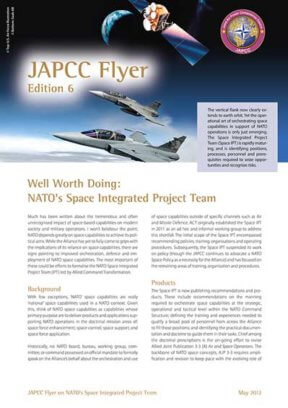Much has been written about the tremendous and often unrecognised impact of space-based capabilities on modern society and military operations. I won’t belabour the point; NATO depends greatly on space capabilities to achieve its political aims. While the Alliance has yet to fully come to grips with the implications of its reliance on space capabilities, there are signs pointing to improved orchestration, defence and employment of NATO space capabilities. The most important of these could be efforts to formalise the NATO Space Integrated Project Team (IPT) led by Allied Command Transformation.
Background
With few exceptions, ‘NATO’ space capabilities are really ‘national’ space capabilities used in a NATO context. Given this, think of NATO space capabilities as capabilities whose primary purpose are to deliver products and applications supporting NATO operations in the doctrinal mission areas of: space force enhancement; space control; space support; and space force application.
Historically, no NATO board, bureau, working group, committee, or command possessed an official mandate to formally speak on the Alliance’s behalf about the orchestration and use of space capabilities outside of specific channels such as Air and Missile Defence. ACT originally established the Space IPT in 2011 as an ad hoc and informal working group to address this shortfall. The initial scope of the Space IPT encompassed recommending policies, training, organisations and operating procedures. Subsequently, the Space IPT suspended its work on policy (though the JAPCC continues to advocate a NATO Space Policy as a necessity for the Alliance) and has focused on the remaining areas of training, organisation and procedures.
Products
The Space IPT is now publishing recommendations and products. These include recommendations on the manning required to orchestrate space capabilities at the strategic, operational and tactical level within the NATO Command Structure; defining the training and experiences needed to qualify a broad pool of personnel from across the Alliance to fill those positions; and identifying the practical documentation and doctrine to guide them in their tasks. Chief among the doctrinal prescriptions is the on-going effort to revise Allied Joint Publication 3-3 (A) Air and Space Operations. The backbone of NATO space concepts, AJP 3-3 requires amplification and revision to keep pace with the evolving role of space in the Alliance. The IPT is critical to this task as the only entity capable of providing current Space Power thought in the NATO context.
Orchestrating NATO Space
In order to bridge the gap between doctrine and standard operating procedures, the Space IPT also created a practical guide for military space applications. Orchestrating NATO Space: Practical Considerations for NATO Space Power Employment is designed for the person with limited exposure to military applications of space power. Orchestrating NATO Space doesn’t answer every question; in fact it poses many of its own, but it does address some of the fundamentals a person new to NATO Space may have up front. The concept is to provide a start on the difficult task of determining how to defend, expand and orchestrate the use of space capabilities for NATO, always keeping in mind that space capabilities are simply additional tools for the commander to use in pursuit of mission accomplishment.
One of the key concepts the IPT incorporated into Orchestrating NATO Space is the idea of including space capabilities into combined force packaging. Airmen commonly acknowledge combined force packaging as the primary means to maximise strengths and minimise weaknesses. Today’s combined force packages already include space capabilities, but this is largely transparent to the rest of the package and often the result of engineering level integration instead of active planning. However, the advantages and disadvantages of operations in the space domain merit more detailed assessment. Some considerations for combined force packaging with space capabilities include:
- What effect are you trying to achieve? This is obviously the most important question for the application of any military force and space is no different.
- How will the adversary attempt to stop you from trying to accomplish what you want to accomplish? Orbits are predictable. This may result in the adversary intentionally avoiding detection during satellite over-flight times.
- Have you accounted for the time and manpower associated with satellite ISR?
- Can you combine sensor data from complimentary sources to reveal a more comprehensive picture?
- What is the orbit? This will tell you how often and for how long you will have the possibility to use a particular satellite.
- What earth location are you concerned with? Different latitudes have different operational considerations.
- What is the terrain? The view to a satellite can be shielded by natural and manmade obstructions.
- What impacts can you expect from the weather; solar or terrestrial? Anyone with satellite TV knows rain and satellite signals in certain bands don’t mix well.
Expanding the IPT Role and Membership
As evidenced above, the operational art of space power in military operations is only beginning to emerge, along with the recognition that NATO’s vertical flank extends to earth orbit. The recent participation of NATO in Schriever Wargame 2012 International in April 2012 and the use of wargame findings for on-going projects is another positive sign. But despite these recent advancements, much work remains and the progress is tenuous. The accomplishments of the Space IPT will only achieve lasting and consistent impact for NATO with official recognition and increased participation. Fortunately, the Military Committee recognises the value of the IPT and the crucial role it can perform. As many of the IPT’s founding members now prepare for new assignments elsewhere, Nations (space-faring or not) and NATO organisations must firmly establish themselves within the Space IPT as it moves towards formalisation and further increases the capacity of the Alliance.











